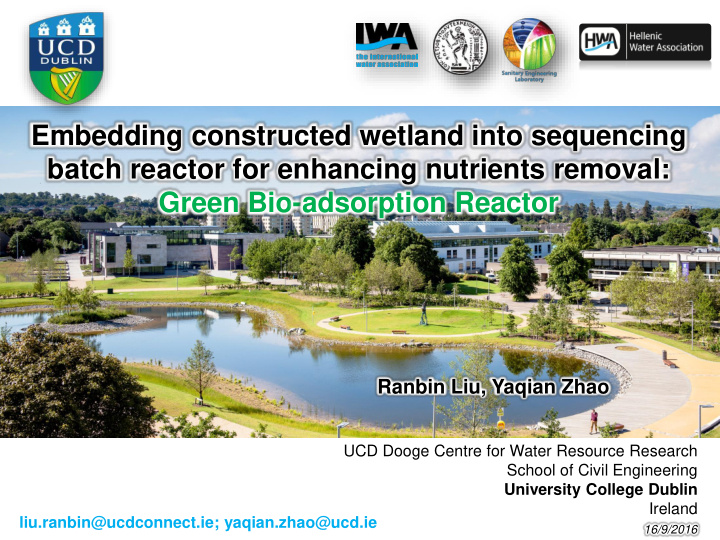



Embedding constructed wetland into sequencing batch reactor for enhancing nutrients removal: Green Bio-adsorption Reactor Ranbin Liu, Yaqian Zhao UCD Dooge Centre for Water Resource Research School of Civil Engineering University College Dublin Ireland liu.ranbin@ucdconnect.ie; yaqian.zhao@ucd.ie 16/9/2016
Content - Background - Background - Methods - Highlights - Conclusion and further work [From online]
Eutrophication Algae bloom N P Point source pollution from WWTPs ~12% contribution to eutrophication Oxygen depletion undesirable odor
Upgrading or stabilizing the nutrients removal in biological unit Conventional methods External carbon Promising denitrification Carriers addition Biological unit Increasing nitrifier Phosphorus Enhancing P removal precipitation Multivalent metal ions
Alum sludge holds the potential taking functions in activated sludge system Robust P adsorption capacity 14.5 mg-P/g Alum sludge Aerobic tank CW Integrating these two technology?
Alum sludge holds the potential taking function in activated sludge system Three tech-functions In One solution P adsorption Phosphorus Multivalent precipitation metal ions Carriers for bacteria Carriers addition Air Saving organic External Aeration Tank carbon Green Bio-adsorption Reactor
Wastewater treatment “PARK” Wastewater treatment PLANT and potential carbon sink Aesthetic value Source of odor CO 2 CO 2 CO 2 CO 2 [From online]
Content - Background - Methods - Methods - Highlights - Conclusion and further work [From online]
Wastewater Piggery wastewater from a farmland COD: 400 ±80 mg·L -1 + -N NH 4 30 ± 9 mg·L -1 P Configuration of reactor 15 ±4 mg·L -1
Operating in SBR mode for 3 months initially Parameter Value Parameter Value DO (mg·L -1 ) Cycle time (h) 24 2.5-4 HLR (m 3 ·m -3 ·d -1 ) SS (mg·L -1 ) 0.6 1,500-2,000 OLR (g·m -3 ·d -1 ) 242 ± 178 Exchange ratio 0.6 Settling No anaerobic Outflow Aeration Inflow Anoxic stage Time distribution in one cycle
Content - Background - Methods - Highlights - Highlights - Conclusion and further work [From online]
Averagely 96% BOD removal
Day 0 Day 30 Day 90 Deterioration of P removal performance The suspended sludge filled and reduced the active alum sludge Satisfied P removal at the beginning surface
50~96% TN removal The removal performance also deteriorated at the end because of decreased SND induced by suspended sludge blockage
Robust SND process SND process contributes to the TN removal
(a) Suspended sludge Biofilm Biofilm (b) Liquid phase Alum sludge Alum sludge AOB N 2 N 2 DB DB O 2 NH 4 + - O 2 NO 3 - AOB NO 3 - - NO 2 + NO 3 NH 4 - NO 2 Organics Organics HB HB Comparison of SND with biofilm only (a) and with biofilm/suspended sludge together (b)
CO 2 CO 2 Present GBR CO 2 CO 2 Electricity Conventional WWTP Electricity Potential carbon-sink of Green Bio-adsorption Reactor (GBR)
Content - Background - Methods - Highlights - Conclusion and further work - Conclusion and further work [From online]
Conclusions o As P-adsorptive material, alum sludge could enhance nutrients removal effectively o The high aesthetic value of GBR makes it advantageous o Carbon-sink property induces sustainability Further work o The impact of alum sludge on EBPR o the optimal placement of alum sludge
Thanks! Question?
Recommend
More recommend